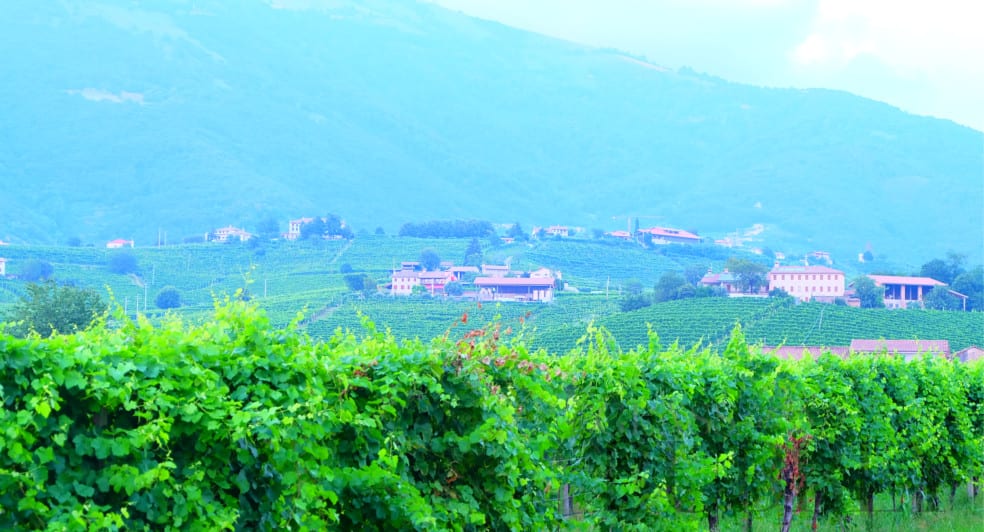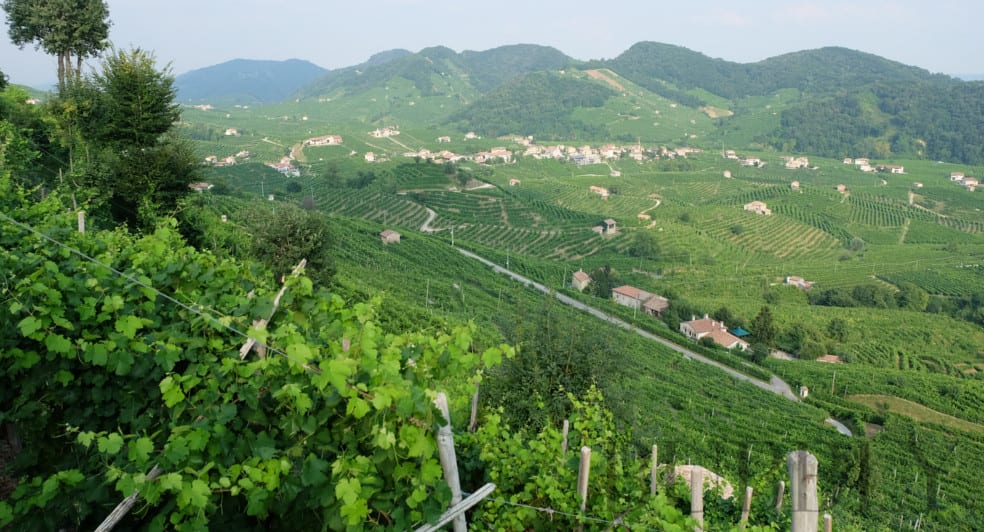Prosecco – Running for the Hills
27th January 2021

Many of the finer wine regions across the world obtain great influence from the land in which their vines are grown. The terroir, which mostly translates to the land and weather influence, will greatly affect the style of wine (grapes) that can be produced and the final quality that the consumer gets to enjoy.
We will mostly see vineyards with waterways passing through or those which extend up to the hills and mountains, lots are also produced on simply flatter land enabling a much easier year-round maintenance and harvest. The more desirable and better performing the terroir then the likelihood of a costlier price point of the wine.
The Prosecco region of Italy, producing its world-famous namesake sparkling wine, is a great example of a wine region that starts off with large plains of flat land for mass production to some of the most wonderful picturesque steep hillsides full of vines. Prosecco is split into two classifications which acknowledges the differing terroir quality – The DOC and the DOCG.
The Prosecco DOC classification is produced in 9 areas across two regions, spanning about 20,000 hectares of relatively flat land. Here mostly the mass-produced bigger wineries use their grape harvests to produce their most popular and easy drinking labels. When visiting your local supermarket store it will usually be the ‘DOC’ Prosecco that you see and especially those which are on offer/promotion.
The Prosecco DOC region will produce standard quality though this will not mean that many are not of very good standard. Though if we compare the classification of the DOC to that of the DOCG then we are highly likely to experience a difference in quality, some cases it is quite noticeable.
The Prosecco DOCG (superior) classification is produced in one compact region (between the towns of Conegliano and Valdbiadenne of the province of Treviso). The area is much smaller, some 6,500 hectares and in most parts is made up of steep hilly terrain. It is truly the most wonderful destination for those that wish to explore the world of wine tourism (since 2019 a Unesco’s World Heritage Site).

Cartizze region
Within this region, we will also find what many agree is the premium grapes for producing Prosecco, this is the Cartizze (107 hectares) which really is the ‘Grand Cru’.
“When it comes to the best Proseccos then we must take to the hills in order to discover them.” Christopher Walkey
I have enjoyed over 15 trips to the Prosecco wine region in the last few years and tasted through countless labels to clearly see an indication of how the terroir affects the final quality. Many Prosecco houses/producers will have a range of labels that they sell which usually sees both DOC and DOCG examples. You are nearly always presented first with the DOC then scale up to DOCG – Price per bottle will also run in this order.
I am pleased to currently be the top reviewer of Prosecco on Vivino in the UK: https://www.vivino.com/users/glassofbubbly
Some wine experts will say that planting of vines on hillsides does not guarantee you a better quality of wine, that I understand to an extent, not all hillsides/slopes offer the best terroir and we have to determine the correct grapes to use – Wine production will also play an important part of the final quality of wine produced. Though, slopes and hilly terrain will offer the likes of added drainage/irrigation, better sun exposure, warmth/heat, soils as well as certain protections against frost. In most cases, we do see the vineyards located within the hills from wine regions across the world showing some of the most iconic and loved wines.
As you approach the region of the Prosecco DOCG you will see the foothills of the Dolomites, the ‘Prosecco Hills’. This wonderful expansion of hills and valleys are what contain much of the grape production for making the wines, during harvest time these are all full of ladies and gentlemen pickers. Some of the hills have a slope of 50% making harvest incredibly challenging (and dangerous) every year.
With thanks to Villa Sandi Prosecco for the sample bottles – I decided to share with you not only the visual delights between the three regions (DOC, DOCG & DOCG Cartizze), but also the expression via the wines. Villa Sandi is a multi award-winning winery world-famous for their Prosecco production of which they produce and have vineyards in each of the classifications.

Tasting DOC DOCG and DOCG Cartizze
Presented with the three styles of Prosecco it is quite clear how they differ immediately from the aromas and this thought is further proven to be correct by the flavours. The styles are without a doubt the artwork of a single wine-house / winemaker, yet they express very different values and will certainly cater for many different requirements.
Prosecco DOC Label: “Clean and fresh yellow and green fruits on the nose. Fresh, smooth and elegant flavours with a soft near creamy expression of green pears and yellow apple.”
Prosecco DOCG Label: “Golden fruits and cream on the nose. An expressive delight of fresh green and yellow fruits in flavours with a creamy, honey edge.”
Prosecco DOCG Cartizze Label: “Complex aromas from passion fruit to a touch of Italian cured ham. As if the wine goes through many years of ageing with an expression of dried apricots, green apple, white floral even a whisper of a caramel pastry that competes for attention in the palate.”

Fine Prosecco – Villa Sandi Italy
The three wines tasted from Villa Sandi were:
Prosecco DOC: Il Fresco Brut Treviso
Prosecco DOCG: Valdobbiandene Millesimato Superiore 2019
Prosecco DOCG Cartizze: Vigna La Rivetta
![]()
Christopher Walkey
Co-founder of Glass of Bubbly. Journalist and author focused on Champagne & Sparkling Wines and pairing them with foods.
